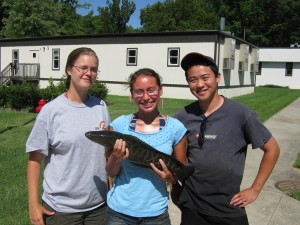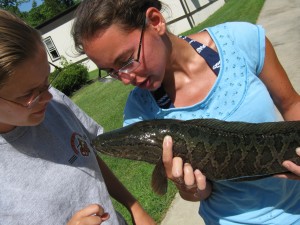
Students on the SERC sampling team, with the 23-inch female snakehead fish they helped ensnare: Diana Sisson (intern), Alison Everett (visiting student), and Philip Choy (intern).
It was around 3 p.m., and it was time to pull the last seine net of the day. We had been out on the water since 10 a.m., and we had already caught a few rarer species, including a stingray and a few juvenile Common Carp. Research biologists Eric Bah and Stacey Havard volunteered to pull what may be the seine of their career.
Upon approaching the shore, the net began to move irregularly with commotion atop the water’s surface. I realized a large specimen had been trapped in the net, but the intensity of its struggles attested to its resilience to be caught. Large fish can easily jump over the floating line of a seine and with that in mind, my instincts took control. I ran into the water, raising the float line just in time as the animal breached the surface. It appeared for just an instant, and we could only dream about what large and ferocious animal we had caught this time. Our imaginations ran wild. Was it a carp? Another stingray? An otter?! The animal struggled as we pulled the net onto the beach, exciting the minds and nerves of everyone present. Our conservation intuition triggered the urgency to get this large fish out of the net before it injured the remainder of our catch.
Once the fish was revealed, I knew exactly what it was. As a Californian and a fisherman, I had read about east coast snakehead fishing and the prize and significance of catching one. The stories from snakehead anglers and exotic species biologists proved to be vital information. I immediately identified the fish as a snakehead, grabbed it and secured it in a bucket far up the beach. The fish displayed its apex predator characteristics with large teeth, an optimal streamline body, relentless strength and a unique cryptic coloration.
At first glance, it was obvious that snakeheads would pose an enormous threat to nearby fish. We discussed the seriousness of our discovery while maintaining the composure required to gather the remainder of our data. Back at the lab, scientists were shoulder to shoulder in order to get a peek at this rare and important fish. Camera flashes and ethanol jars were all around as everyone was documenting and studying this organism. Samples have since been taken, and the fish was preserved for further analysis.
This snakehead was the first one of its kind to be captured and reported in the Rhode River tributary, stimulating the nerves of many biologists as this fish can have drastic consequences on native and commercially important species. New snakehead sightings are appearing around the Chesapeake Bay, and each finding provides more and more insight into the struggle to control snakehead expansion and destruction.
–Philip Choy, SERC invasions intern

Diana Sisson (left) and Alison Everett take a closer look at the snakefish before the lab dissects it. When they cut it open in lab, they discovered thousands of eggs inside.
It was our last seine of six at this particular sampling point. We were happy that we had avoided the major speed bumps of sampling (algae, ulva or large schools of delicate fish). I wasn’t personally pulling the seine, but from observation I could tell that the net was heavy. We had already landed a large stingray earlier in the day, and I was eager to perhaps see another one. When the net was halfway through the transect, something large jumped out of the net too fast to identify (always disappointing). Another intern, Philip Choy, waded out to lift the float line of the net and keep anything else from escaping. It was at the point where we start beaching the net that the real fun started. Something large was putting up one heck of a fight in our net.
Is it a carp? Is it a ray? No, it’s a snakehead! But wait…what’s it doing here?
Initial reactions were interesting. While we were eager to stare and gawk at our amazing find, we had a good number of fish in our bins that needed recording, and they were not as hardy as a snakehead. The one thing we were certain of was that it could not be allowed back into the water. Snakeheads are voracious eaters and are remarkably hardy out of water. We placed it in a bucket and went back to the smaller fish.
I happen to carry a camera with me at all times in the field for occasions just like this. Let me say that my shutter finger was itching the whole time. All of us kept glancing over at the bucket with the huge tail sticking out, wondering how on earth it got here.
After getting the animal a good distance from water, we stopped to examine it, taking pictures and making observations as to its health (having small lesions, crawling with little copepods or isopods). It also felt rather fat (we later discovered it was carrying a large number of eggs).
Back at the lab, we ended up with a small mob surrounding the truck and fish. What should we do with it? DNR (the Department of Natural Resources) says that as soon as an angler catches a snakehead, it needs to be killed. Should we dissect it now? Could we confirm the species? Are there more out there? I felt rather giddy during the whole afternoon – it was so exciting! A calm and peaceful day had turned into a scientific adventure where our sole focus was on one huge fish.
I would call the taste of discovery more addictive than chocolate. Suddenly everyone is an expert on something, throwing out a theory as to the reasoning behind some unfathomable event. Even a lowly intern may have something valuable to say. There is now even more work that you never expected, and everyone around you is ecstatic and stressed at the same time. The events following the initial discovery continue to make ripples long after the fish first leaps out of the water.
–Diana Sisson, SERC invasions intern


a discovery both cool for the interns and disturbing for the estuary. Glad you were able to get this female before she spawned. California has had some near misses with this “frankenfish”, I shudder to think if it gets established here. (I was an intern in 1988, also an asst in the Crab Lab)
That fish in my country call Ikan Tomman or snakehead fish. Thats a carnivora fish.
I read that this snakehead fish is carnivora. Isn’t it dangerous to help ensnare too much ? You talked about thousands of eggs …